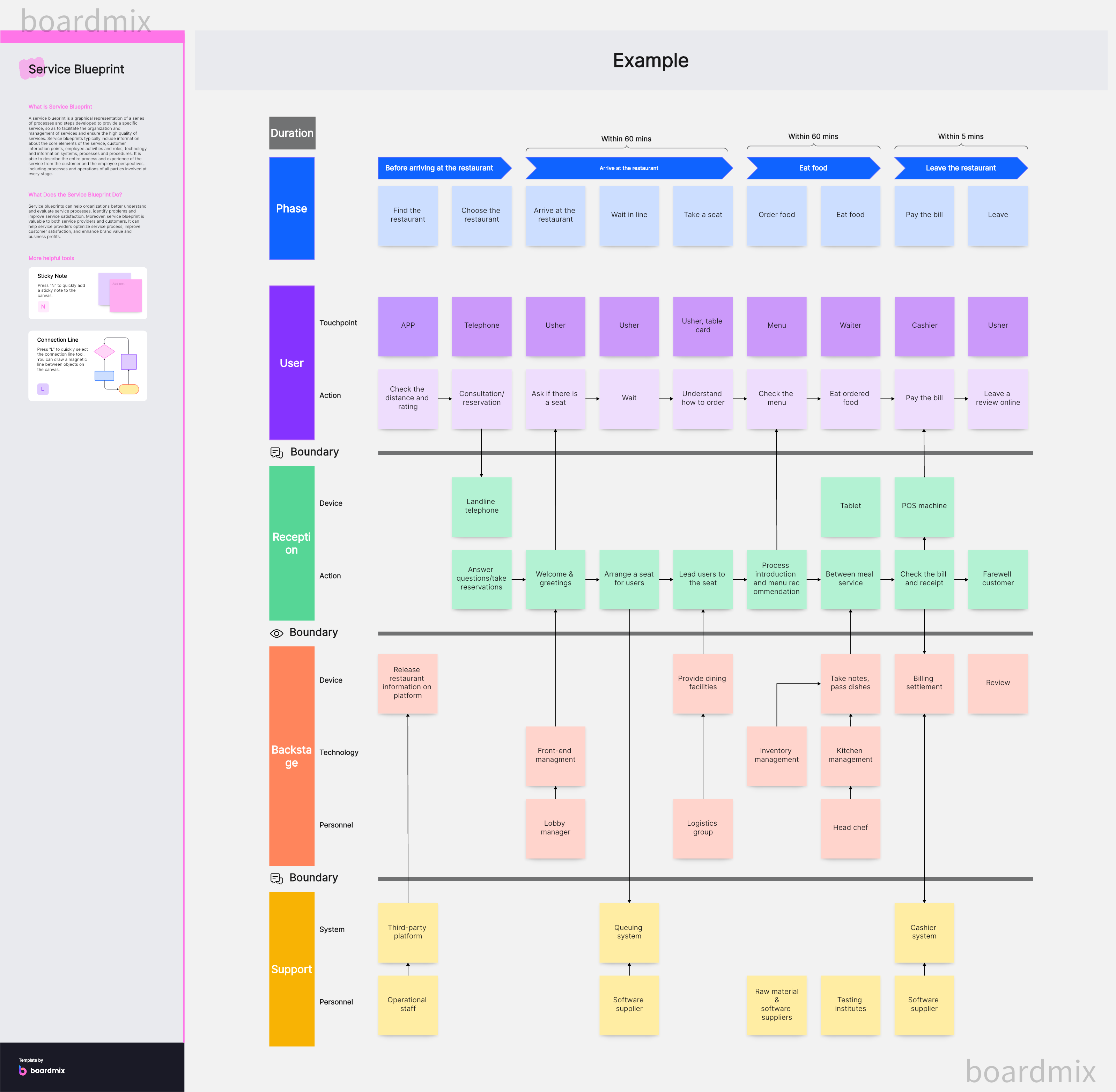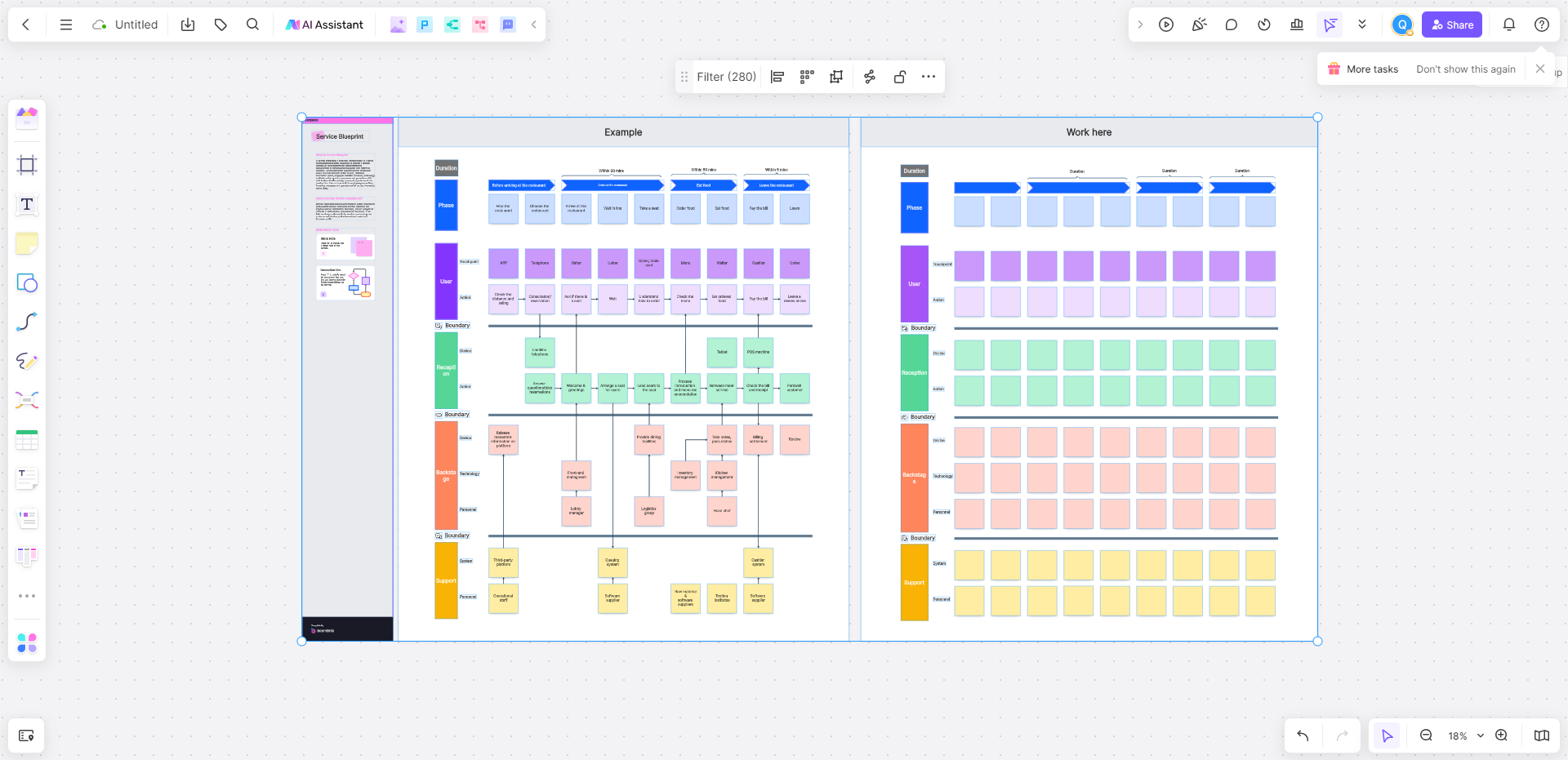Service Blueprinting- it may sound like a complex term, but it's a straightforward, practical approach that can revolutionize the way you operate your business. This technique is all about mapping out your service processes, laying bare every step, every interaction, and every potential bottleneck. But how does one create a service blueprint? And more importantly, how can it truly transform your business operations? Let's embark on this journey of discovery together, exploring the art and science of Service Blueprinting and its potential to elevate your business to new levels of operational efficiency.
What is a Service Blueprint?
A 'Service Blueprint' essentially serves as an illustrative guide mapping out every stage & interaction involved within a given servicing framework aimed at comprehending & refining service delivery mechanisms to not just meet but exceed customer anticipations. This concept was first introduced & developed by Shostack back in 1984.

What are the Five Components of Service Blueprint?
A typical Service Blueprint encompasses five key components: Customer Actions, Frontline Interactions, Behind-the-scenes Interactions, Support Processes, and physical Evidence. Here's a brief on each:
Customer Actions: Encompasses all activities undertaken by customers whilst availing services.
Frontline Interactions: Pertains to direct contact points where customers engage with service providers.
Behind-the-scenes Interactions: Involves internal operations executed to facilitate frontline interactions; these activities generally remain unseen by customers.
Support Processes: Refers to internal workflows ensuring seamless service delivery such as IT support, supply chain management etc.
Physical Evidence: Includes all tangible elements that customers encounter during the service process like infrastructure, equipment, personnel, etc.
Why Use a Service Blueprint?
Service blueprinting offers several benefits for organizations. Some of the key benefits include:
Streamlining Service Delivery: Crafting a Service Blueprint allows businesses to gain deeper insights into their servicing process thereby enabling them to identify & rectify potential issues or bottlenecks thus enhancing operational efficiency & quality.
Enhanced customer experiences: By mapping out the customer journey and aligning it with internal processes, organizations can identify pain points, bottlenecks, and opportunities for improvement. This enables them to design and deliver seamless and exceptional customer experiences, ultimately leading to higher customer satisfaction and loyalty.
Increased employee engagement: Service blueprinting involves collaboration and input from various stakeholders within an organization. By involving employees in the blueprinting process, organizations can foster a sense of ownership and engagement among employees, leading to higher motivation, productivity, and job satisfaction.
Effective communication and alignment: Service blueprinting provides a visual representation of the service journey and the touchpoints involved. This makes it easier for organizations to communicate and align their internal teams and departments, ensuring a consistent and coordinated approach to service delivery.
Identification of innovation opportunities: Through service blueprinting, organizations can identify areas where they can introduce new technologies, processes, or strategies to enhance the service experience. This enables them to stay competitive, adapt to changing customer needs, and drive innovation within their industry.
Service blueprinting is a valuable tool for organizations to understand and improve their service delivery. It helps them create exceptional customer experiences, optimize operational processes, engage employees, align internal teams, and identify opportunities for innovation. By leveraging service blueprinting, organizations can gain a competitive advantage and achieve long-term success in their respective markets.

Who Uses Service Blueprint?
The service blueprint is a powerful tool that is widely used in various industries and organizations, especially those enterprises that regard service as their core competitiveness. Below, we will introduce in detail some common users of the service blueprint:
Service industry enterprises
Hotels, catering, tourism, retail, banks and other service industry enterprises are the main users of the service blueprint. They use the service blueprint to understand, design, and improve their service processes to enhance customer experience.
Consulting companies
Many consulting companies use service blueprints to provide customers with professional service design and optimization suggestions. They can comprehensively analyze the customer's service process with the help of a service blueprint and propose targeted solutions.
Software and technology companies
With the development of digitalization and technology, more and more software and technology companies have begun to apply service blueprints. They mainly use the service blueprint to design and optimize their user experience and customer service processes.
Public sector
Government departments and non-profit organizations also use a Service Blueprint. For example, medical institutions may use a Service Blueprint to optimize their medical services; educational institutions may use a Service Blueprint to improve students' learning experiences.
Design and innovation teams
Within many companies, design and innovation teams also use a Service Blueprint as an innovative tool. They can explore new ideas for designing services through a Service Blueprint.
No matter who it is when applying a Service Blueprint, the key is to understand and pay attention to customer needs, and center on customers in designing & optimizing services. Only in this way can we truly improve customer satisfaction & establish long-term stable customer relationships.
How Service Blueprints Help You Map Your Service Processes?
Service blueprints help organizations map their service processes by providing a visual representation of the customer journey and the internal processes that support it. This mapping helps organizations understand the flow of their services, identify touchpoints, and uncover potential pain points or areas for improvement. Here's how service blueprints can help map service processes.
Visual representation: Service blueprints visually represent the entire service journey, including the various steps, actions, and interactions involved. This helps organizations gain a holistic view of their service processes and understand how different components are interconnected.
Customer-focused perspective: Service blueprints prioritize the customer's perspective by mapping out their interactions at each touchpoint. This helps organizations understand the customer's experience, identify moments of truth, and ensure that their service processes align with customer expectations.
Identification of front-stage and back-stage processes: Service blueprints distinguish between front-stage processes (visible to the customer) and back-stage processes (internal operations). This differentiation helps organizations understand how their internal processes support the delivery of a seamless customer experience.
Mapping of customer actions and employee actions: Service blueprints map both customer actions and employee actions, highlighting the interactions and responsibilities at each touchpoint. This helps organizations identify areas where customer actions may be unclear or where employees may need additional training or support.
Identification of potential bottlenecks and inefficiencies: By mapping out the service processes, organizations can identify potential bottlenecks, delays, or inefficiencies in their operations. This allows them to proactively address these issues and optimize their processes for improved service delivery.
Collaboration and alignment: Service blueprints involve collaboration among various stakeholders within an organization, including employees from different departments. This collaboration helps align internal teams and ensures a coordinated approach to service delivery.
Service blueprints serve as a valuable tool for mapping service processes. They provide a clear and visual representation of the customer journey, help identify areas for improvement, and enable organizations to deliver exceptional customer experiences.
How to Map Your Service Blueprint?
Mapping a service blueprint involves several steps. Here's a general guide on how to map your service blueprint.
1. Identify the customer journey: Start by understanding the different stages of your customer's journey. This includes the various touchpoints, interactions, and actions that occur from the initial point of contact to the final service delivery. Map out each step in chronological order.
2. Define customer actions: Identify the specific actions that customers take at each touchpoint. This could include actions such as making a phone call, filling out a form, or interacting with a website. Be specific and detailed in capturing these actions.
3. Identify employee actions: Determine the actions that employees take to support the customer journey. This could involve tasks such as answering customer inquiries, processing orders, or providing technical support. Document these actions alongside the customer actions.
4. Map out interactions: Visualize the interactions between customers and employees at each touchpoint. This could include face-to-face interactions, phone calls, emails, or online chat conversations. Use symbols or icons to represent these interactions on your service blueprint.
5. Outline front-stage and back-stage processes: Differentiate between front-stage processes (visible to the customer) and back-stage processes (internal operations). This helps you understand how your organization's internal processes support the delivery of services to customers.
6. Capture timeframes: Indicate the timeframes for each step in the customer journey. This helps you identify potential bottlenecks or delays in your service delivery.
7. Identify pain points and opportunities: As you map out your service blueprint, pay attention to pain points or areas where customers may face challenges or frustrations. Also, look for opportunities to enhance the customer experience or streamline your processes.
8. Involve stakeholders: Collaborate with stakeholders from different departments within your organization to ensure that all perspectives are considered. This can include representatives from customer service, marketing, operations, and IT.
9. Continuously review and update: Service blueprints should be living documents that are regularly reviewed and updated as your organization evolves. Make it a practice to revisit your service blueprint periodically to identify areas for improvement and ensure alignment with changing customer expectations.
By following these steps, you can effectively map your service blueprint and gain a deeper understanding of your service processes. This will help you identify opportunities for improvement, enhance the customer experience, and deliver exceptional services.
Boardmix: Create Your Own Service Blueprint Online for Free
Creating a service blueprint is an important step in designing and improving your service delivery. If you're looking for a convenient and free way to create your service blueprint online, Boardmix is a great option.
Boardmix provides an intuitive platform that allows you to easily map out your customer journey, identify touchpoints, and visualize the interactions between customers and employees. With its user-friendly interface, you can quickly capture customer actions, employee actions, and the various processes involved in delivering your services.
One of the key features of Boardmix is its collaborative nature. You can invite stakeholders from different departments to contribute their insights and perspectives, ensuring that all aspects of your service delivery are taken into account. This collaborative approach helps foster alignment and drives continuous improvement.
Furthermore, Boardmix offers customizable templates and symbols to represent different elements of your service blueprint. You can easily modify and adjust the layout to fit your specific needs and requirements.

Overall, Boardmix is a powerful tool that enables you to create your own service blueprint online for free. By mapping out your service processes, identifying pain points, and uncovering opportunities for enhancement, you can deliver exceptional services and improve the overall customer experience.














